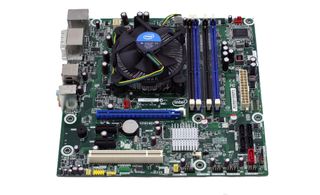Intel vPro: Three Generations Of Remote Management
It's common to manage PCs remotely in today's business environment. Intel's vPro technology aims to simplify that task by giving IT professionals hardware-level tools to make remote management easier. Today we look at three generations of vPro.
Intel Core i5-670 And DQ57TM: The Clarkdale Generation
When Intel launched its Clarkdale-based CPUs in the first quarter of 2010, it marked a major architectural shift for business PCs. The dual-core CPU was manufactured using a 32 nm process, while the GPU, memory controller, and a 16-lane PCI Express 2.0 controller (all formerly found in the chipset northbridge), were etched on a 45 nm process and added to the CPU package.
While the improved graphics engine paved the way for lower overall power consumption, Intel also made big changes to the processor's execution cores using its Nehalem architecture. Furthermore, the Core i5 models featured one notable feature that was sure to interest organizations concerned about security: AES-NI. Accelerated AES encryption and decryption allowed apps that recognized it to take advantage of a handful of instructions that offloaded what was once a significant software-based workload to hardware. This made it possible for IT managers to turn on hard drive encryption without a significant performance impact using standard like BitLocker and McAfee Endpoint Encryption. Having seen colleagues get their notebooks stolen and after responding to PCs being stolen from the headquarters of a large multi-national corporation, it's quite clear that drive encryption should be a mandatory security precaution on any PC with sensitive business information.

Accompanying the Core i5-670 was Intel's DQ57TM motherboard. Like the DQ45CB, the DQ57TM shares a similar footprint and expansion slot layout.
By default, the DQ57TM supports Intel's AMT 6.0. Compared to the previous generation, AMT 6.0 added Intel KVM Remote Control support, while version 6.1 added additional KVM resolutions. As we'll see later in this story, inclusion of KVM and IDE-R (IDE redirection) is a major feature set enhancement. Although Intel clearly intends these technologies to help in the enterprise segment where techs are already overextended, it's equally useful to service providers managing SMBs remotely. The power to respond almost immediately to a call for help from a business owner without his own IT department gets that customer one step closer to the experience an enterprise-based employee would see.
The Q57 platform generation was the first time I saw hardware-based KVM-over-IP used in a home setting to remotely troubleshoot PCs. One could also use the technology to monitor child computer usage, since it facilitates remote desktop viewing without any installed software.
Stay on the Cutting Edge
Join the experts who read Tom's Hardware for the inside track on enthusiast PC tech news — and have for over 25 years. We'll send breaking news and in-depth reviews of CPUs, GPUs, AI, maker hardware and more straight to your inbox.
Current page: Intel Core i5-670 And DQ57TM: The Clarkdale Generation
Prev Page Intel Core 2 Duo E8500 And DQ45CB: The Wolfdale Generation Next Page Intel Core i5-2500 And DQ67SW: The Sandy Bridge Generation-
cngledad Can I suggest an article comparing different remote access tools we can use? From the freeware TeamViewer, VNC Viewer to such things like WebEx? I think that would be a very good topic.Reply -
One correction: DQ57TM *does* contain a v1.2 TPM, the same as found on DQ67SW and DQ67EP. It's required to be vPro compliant (necessary for Intel TXT).Reply
-
jhansonxi Nifty but I don't like the single-vendor lock-in. I can see real improvements in IT efficiency if this was combined with AoE. Would like to see SSH support, however.Reply -
extremepcs Hopefully they have improved the activation mechanism. Kind of a PITA if you don't buy a certificate from a trusted CA. I used an internal cert and had to activate each machine by booting from a flash drive.Reply -
chovav If my hard drive is encrypted using TrueCrypt pre-boot authentication, would I be able to fill in the password using Intels vPro?Reply -
jowunger The voice of the guy in the video is bad. The guy talks like he is speedreading a book...Reply -
cangelini cdw-vproOne correction: DQ57TM *does* contain a v1.2 TPM, the same as found on DQ67SW and DQ67EP. It's required to be vPro compliant (necessary for Intel TXT).Reply
Fixed, thanks!
Most Popular

